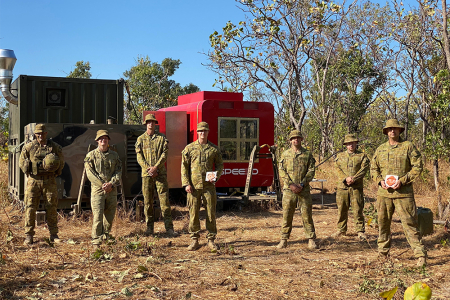News Article
3D print training assists Australian Army in remote NT
Charles Darwin University engineers have travelled to a remote area in the Northern Territory to train Australian Army soldiers in cutting-edge metal 3D printing technology.
The training is part of a $1.5million partnership between the Australian Army, CDU’s Advanced Manufacturing Alliance (AMA) and technology developer SPEE3D.
The 12-month pilot program includes training soldiers in 3D printing on the LightSPEE3D metal printer on Casuarina campus and trialling SPEE3D’s large format WarpSPEE3D 3D metal printer in remote locations of the Northern Territory.
Little over a week after arriving at Darwin’s Robertson Barracks, soldiers from the 1st Combat Service Support Battalion (1 CSSB) deployed the printer to Mount Bundey field training area, 120km south east of Darwin.
AMA engineer Matthew Harbidge said he worked with the soldiers during the tree-day trial in the operation and set-up of the printer.
“The aim of the exercise was to trial the transport, set-up and operation of the equipment in the field in various locations across uneven terrain,” Mr Harbidge said.
“We were able to easily transport and set-up up the printer to be operational and ready to print within about 30 minutes.”
This follow on from an initial 10-week training period with AMA engineers covering everything from the fundamentals of design, 3D modelling and printing, to testing and certification.
1 CSSB Commanding Officer, Lieutenant Colonel Kane Wright said this phase had seen the 3D printing capability deployed to the field, alongside vital military equipment, contributing to the mission during this training cycle
“The ability to print repair parts in an environment like this has the potential to significantly reduce our footprint and repair damaged equipment – on the spot – to get us back to our main priority,” Lieutenant Colonel Wright said.
The program aims to significantly increase parts available to the Army compared to what the regular supply chain can provide.
Related Articles

Global sewage study reveals condition of Darwin’s harbour
A global study of sewage contamination in harbours, with samples taken from 18 cities across five continents, has revealed that faecal contamination of Darwin Harbour from sewage is very low compared to the rest of the world.
Read more about Global sewage study reveals condition of Darwin’s harbour
Transport study reveals why journey is as important as the destination
A days’ long canoe voyage along the Arnhem Land coast can now be completed within hours in a tinnie, but accelerating movement has unique and complex implications for Indigenous peoples’ relationship with their ancestral Country, according to a new research paper.
Read more about Transport study reveals why journey is as important as the destination
Walk more, drink less – a Nutritionist’s guide to the silly season
With obesity surpassing tobacco as the leading risk factor for disease in 2024, Charles Darwin University’s new Head of Nutrition and Dietetics is encouraging Australians to balance the joy this silly season.
Read more about Walk more, drink less – a Nutritionist’s guide to the silly season
